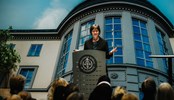Fireside Chat - The Swedish Golf Federation under Change
Participants
The fireside chat on the topic of The Swedish Golf Federation under Change was held between Martin Carlsson-Wall, Director for the Center for Sports & Business, and Gunnar Håkansson, the General Secretary of the Swedish Golf Association.
The Federation in Short
The Swedish Golf Federation is the governing body for the sport of golf in Sweden, founded in 1904. The federation is responsible for administering the Rules of Golf, as laid down by The R&A (collective name of a group of companies that together play a significant role within the game of golf). It organizes tournaments, manages the national teams and promotes the game. In total, the federation consists of 449 golfing clubs with approximately 1,237 members per club. This amounts to over 534,000 members in Sweden, making it the largest federation in terms of members. 26% of the members are women, the average age is 48,4 years and approximately 12% are junior members (with an increase of +49% during the pandemic).
The 50/50 Project
The main theme that Carlsson-Wall and Håkansson discussed was the Golf Federation's 50/50 Project - a response to current challenges the sport is facing. Vision 50/50 is a long-term change project for a more equal and including golf sport, with a more equal gender distribution among players and in leading positions.
Some different action proposals Håkansson brought to the table included:
- Adjust the course setup for better playing experiences for all people
- Give all players the possibility to develop their own golf game
- Establish good quality on the establishment (club house, cafeteria, WC etc.)
- Offer a wider selection in the restaurant
- Arrange golf activities that focus on health & recreation
- Promote playing options that take less time
- Fight out of date attitudes and valuations still existing in golf
In this fact sheet, you can read more about the Golf Federation's 50/50 Vision.
Mini Workshop
During the fireside chat, students contributed with valuable input, perspectives and experiences. The fireside chat also included a mini workshop where students were asked to discuss the different action proposals, and which are the most important as well as why it can be difficult to implement.
















